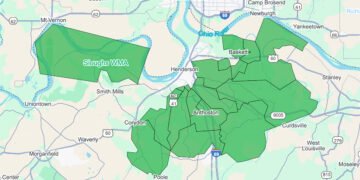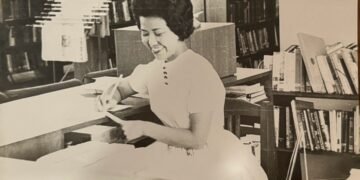(This column first appeared in the October print edition of the Hendersonian.)
You can plan and plan a vacation—or in my case, let your spouse plan vacations.
But it’s helpful to have some flex time, because sometimes, you just don’t know.
So, it was a few weeks ago when we found ourselves with friends at a late breakfast in the historic Hotel Oregon in McMinnville, Oregon, a lovely place southwest of Portland that I had never heard of.
We had been traveling west on Highway 18 toward the Oregon Coast and were pretty hungry. A sign indicated a McDonald’s lay ahead. An informal poll of the car was taken: “Do you want to stop at McDonald’s?” I kept quiet until I saw a sign pointing the way to downtown McMinnville.
Surely it had a better place for breakfast than McDonald’s.
That’s when the Hotel Oregon presented itself. While sitting in our booth I noticed a painting on the wall. I narrowed my eyes and said, “I think that’s the Spruce Goose.”
What I knew about the Spruce Goose—officially, the Hughes H-4 Hercules—could fit into a thimble. It was an enormous seaplane, I’d heard, built improbably out of plywood by the eccentric genius Howard Hughes during World War II. I had seen a grainy black-and-white film of it lifting, briefly, off the water.
But why was there a painting of the Spruce Goose in a hotel eatery in inland Oregon? I Googled that stuff and found out: It’s because the Spruce Goose is housed in the sprawling Evergreen Aviation & Space Museum that we had glimpsed on our way into town. We were a 10-minute drive from laying eyes on the legendary—or, perhaps, infamous—wooden behemoth.
Fortunately, our travel planning allowed time to go take a look.
The Evergreen is quite the place: four sprawling buildings (one of them housing a water park with—I am not kidding—a decommissioned Boeing 747 on the roof) with hundreds of aircraft—an F-177 Nighthawk, a deadly A-10 Warthog, a SR-17 Black Bird spy plane, an historic DC-3—and replicas of historic spacecraft. We spent two hours there and barely scratched the surface.
A lot can be said about the Evergreen museum, but while I’ve enjoyed visiting aviation museums before, there is only one Spruce Goose. Here’s what I learned:
In the early 1940s, the U.S. was shipping war matériel and personnel across the Atlantic to Britain, but German U-Boats were extracting an appalling price; Nazi subs sent some 3,500 merchant vessels to the bottom of the sea at a loss of more than 70,000 sailors and merchant marine men.
The U.S. government had an interest in developing a transatlantic air transport, but it couldn’t be built of strategic materials such as lightweight aluminum desperately needed for proven warplanes.
The industrialist Henry J. Kaiser, a leading builder of Liberty Boats during WWII, recruited Hughes, an aircraft designer, to help create what would become the largest aircraft yet built—a flying cargo ship capable of hauling 750 troops or two 30-ton Sherman tanks high above the U-Boats—and built mostly out of birch (plus eight 28-cylinder Pratt & Whitney engines that could produce more than 4,300 horsepower each). In 1942, an $18 million government contract was issued for development of the giant.
Progress was slow, though, and Kaiser eventually pulled out of the project, in part because of what he called Hughes’ insistence on perfection for the aircraft.
Hughes pressed forward, though the behemoth—six times larger than any aircraft of its time, with a wingspan longer than a football field—wasn’t completed until after the war ended. In 1947, Hughes was called before a U.S. Senate committee investigating the millions of dollars that had been sunk into what some considered a boondoggle.
Stung by the criticism, Hughes scheduled a test run of its ability to taxi on water at Long Beach, Calif., on Nov. 2, 1947, with journalists on board and Hughes at the controls. After taxiing twice, most journalists rushed off board to file their stories. But one radio broadcaster remained on board when Hughes taxied a third time and, to everyone’s surprise, lowered the wing flaps and flew about a half mile just above the waves, proving that he had, in fact, built a functioning aircraft.
The Spruce Goose—Hughes hated that nickname—never flew again. It stayed mothballed out of sight for 33 years. After a few years on display at Long Beach, it was disassembled and transported by barge, then highway to McMinnville, where it’s the star attraction of the Evergreen museum (where my buddy and I happily paid to go inside to the Goose’s flight deck).
But we wouldn’t have had a clue had we not sat at the right booth at a restaurant in a town we hadn’t even known existed before that day.






















